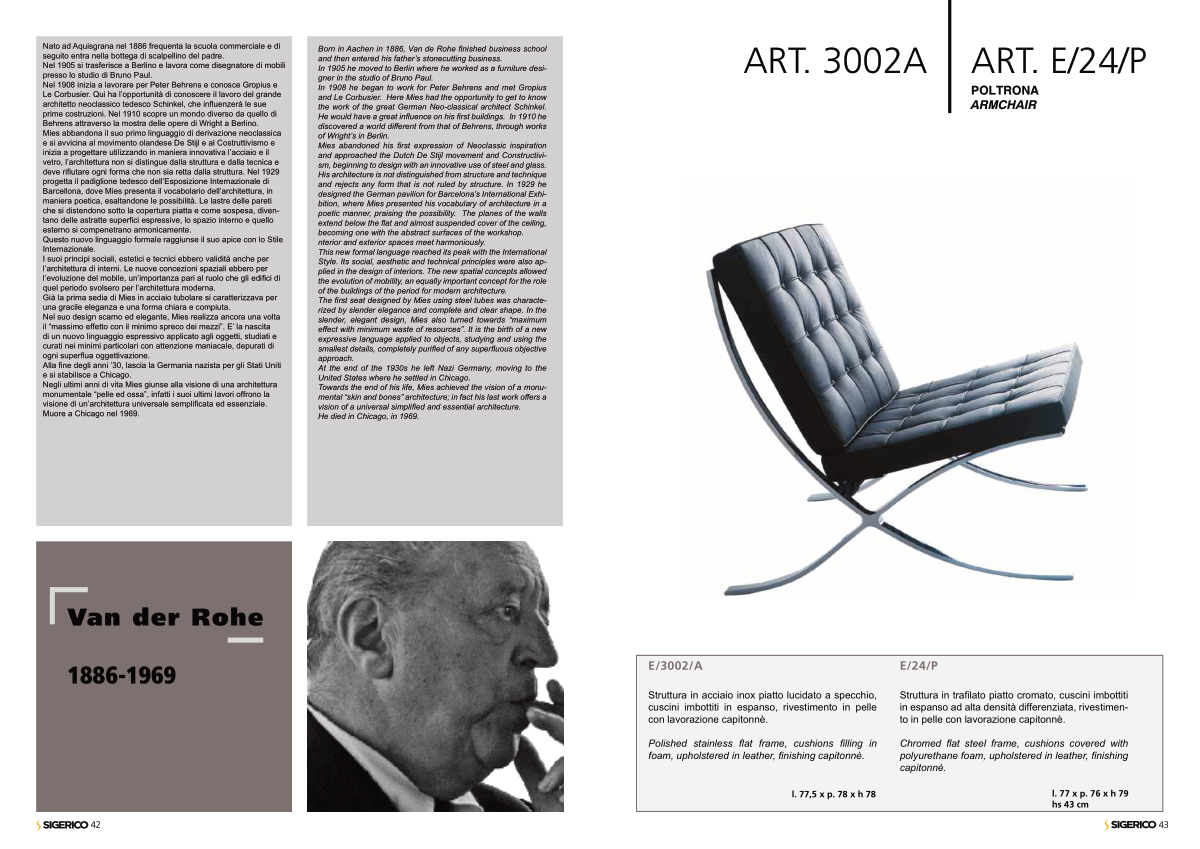Van der Rohe
1886-1969
Nato ad Aquisgrana nel 1886 frequenta la scuola commerciale e di
seguito entra nella bottega di scalpellino del padre.
Nel 1905 si trasferisce a Berlino e lavora come disegnatore di mobili
presso lo studio di Bruno Paul.
Nel 1908 inizia a lavorare per Peter Behrens e conosce Gropius e
Le Corbusier. Qui ha l’opportunità di conoscere il lavoro del grande
architetto neoclassico tedesco Schinkel, che influenzerà le sue
prime costruzioni. Nel 1910 scopre un mondo diverso da quello di
Behrens attraverso la mostra delle opere di Wright a Berlino.
Mies abbandona il suo primo linguaggio di derivazione neoclassica
e si avvicina al movimento olandese De Stijl e al Costruttivismo e
inizia a progettare utilizzando in maniera innovativa l’acciaio e il
vetro, l’architettura non si distingue dalla struttura e dalla tecnica e
deve rifiutare ogni forma che non sia retta dalla struttura. Nel 1929
progetta il padiglione tedesco dell’Esposizione Internazionale di
Barcellona, dove Mies presenta il vocabolario dell’architettura, in
maniera poetica, esaltandone le possibilità. Le lastre delle pareti
che si distendono sotto la copertura piatta e come sospesa, diven-
tano delle astratte superfici espressive, lo spazio interno e quello
esterno si compenetrano armonicamente.
Questo nuovo linguaggio formale raggiunse il suo apice con lo Stile
Internazionale.
I suoi principi sociali, estetici e tecnici ebbero validità anche per
l’architettura di interni. Le nuove concezioni spaziali ebbero per
l’evoluzione del mobile, un’importanza pari al ruolo che gli edifici di
quel periodo svolsero per l’architettura moderna.
Già la prima sedia di Mies in acciaio tubolare si caratterizzava per
una gracile eleganza e una forma chiara e compiuta.
Nel suo design scarno ed elegante, Mies realizza ancora una volta
il “massimo effetto con il minimo spreco dei mezzi”. E’ la nascita
di un nuovo linguaggio espressivo applicato agli oggetti, studiati e
curati nei minimi particolari con attenzione maniacale, depurati di
ogni superflua oggettivazione.
Alla fine degli anni ’30, lascia la Germania nazista per gli Stati Uniti
e si stabilisce a Chicago.
Negli ultimi anni di vita Mies giunse alla visione di una architettura
monumentale “pelle ed ossa”, infatti i suoi ultimi lavori offrono la
visione di un’architettura universale semplificata ed essenziale.
Muore a Chicago nel 1969.
Born in Aachen in 1886, Van de Rohe finished business school
and then entered his father’s stonecutting business.
In 1905 he moved to Berlin where he worked as a furniture desi-
gner in the studio of Bruno Paul.
In 1908 he began to work for Peter Behrens and met Gropius
and Le Corbusier. Here Mies had the opportunity to get to know
the work of the great German Neo-classical architect Schinkel.
He would have a great influence on his first buildings. In 1910 he
discovered a world different from that of Behrens, through works
of Wright’s in Berlin.
Mies abandoned his first expression of Neoclassic inspiration
and approached the Dutch De Stijl movement and Constructivi-
sm, beginning to design with an innovative use of steel and glass.
His architecture is not distinguished from structure and technique
and rejects any form that is not ruled by structure. In 1929 he
designed the German pavilion for Barcelona’s International Exhi-
bition, where Mies presented his vocabulary of architecture in a
poetic manner, praising the possibility. The planes of the walls
extend below the flat and almost suspended cover of the ceiling,
becoming one with the abstract surfaces of the workshop.
nterior and exterior spaces meet harmoniously.
This new formal language reached its peak with the International
Style. Its social, aesthetic and technical principles were also ap-
plied in the design of interiors. The new spatial concepts allowed
the evolution of mobility, an equally important concept for the role
of the buildings of the period for modern architecture.
The first seat designed by Mies using steel tubes was characte-
rized by slender elegance and complete and clear shape. In the
slender, elegant design, Mies also turned towards “maximum
effect with minimum waste of resources”. It is the birth of a new
expressive language applied to objects, studying and using the
smallest details, completely purified of any superfluous objective
approach.
At the end of the 1930s he left Nazi Germany, moving to the
United States where he settled in Chicago.
Towards the end of his life, Mies achieved the vision of a monu-
mental “skin and bones” architecture; in fact his last work offers a
vision of a universal simplified and essential architecture.
He died in Chicago, in 1969.
ART. E/24/P
POLTRONA
ARMCHAIR
ART. 3002A
Struttura in trafilato piatto cromato, cuscini imbottiti
in espanso ad alta densità differenziata, rivestimen-
to in pelle con lavorazione capitonnè.
Chromed flat steel frame, cushions covered with
polyurethane foam, upholstered in leather, finishing
capitonnè.
l. 77 x p. 76 x h 79
hs 43 cm
Struttura in acciaio inox piatto lucidato a specchio,
cuscini imbottiti in espanso, rivestimento in pelle
con lavorazione capitonnè.
Polished stainless flat frame, cushions filling in
foam, upholstered in leather, finishing capitonnè.
l. 77,5 x p. 78 x h 78
43
42
E/3002/A
E/24/P


